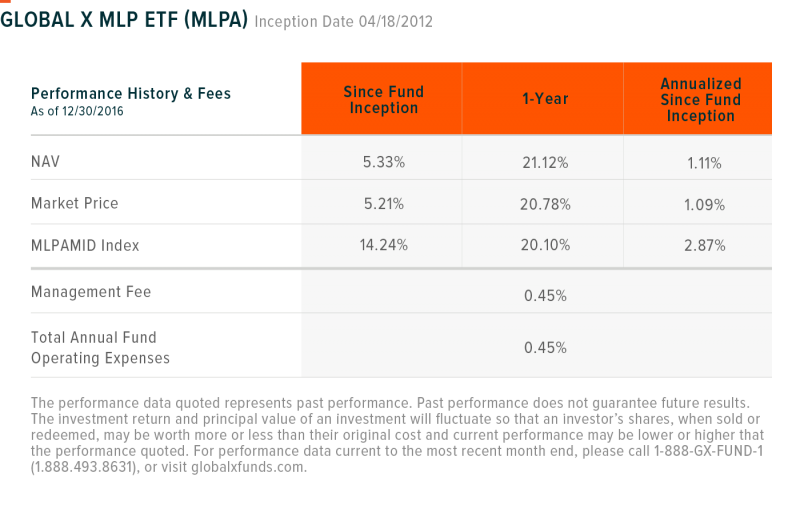EBITDA: Earnings before interest, tax, depreciation and amortization (EBITDA) is a measure of a company’s operating performance. Essentially, it’s a way to evaluate a company’s performance without having to factor in financing decisions, accounting decisions or tax environments.
Global X Management Company, LLC serves as an advisor to the Global X Funds. The Funds are distributed by SEI Investments Distribution Co. (SIDCO, 1 Freedom Valley Drive, Oaks, PA, 19456), which is not affiliated with Global X Management Company, LLC.
Investing involves risk, including possible loss of principal. In addition to the normal risks associated with investing, international investments may involve risk of capital loss from unfavorable fluctuation in currency values, from differences in generally accepted accounting principles or from economic or political instability in other nations. Investments in securities of MLPs involve risk that differ from investments in common stock including risks related to limited control and limited rights to vote on matters affecting the MLP. MLP common units and other equity securities can be affected by macro-economic and other factors affecting the stock market in general, expectations of interest rates, investor sentiment towards MLPs or the energy sector, changes in a particular issuer’s financial condition, or unfavorable or unanticipated poor performance of a particular issuer (in the case of MLPs, generally measured in terms of distributable cash flow). The Fund invests in the energy industry, which entails significant risk and volatility. In addition, the Fund is non- diversified which represents a heightened risk to investors. Furthermore, the Fund invests in small and mid-capitalization companies, which pose greater risks than large companies. The Fund has a different and more complex tax structure than traditional ETFs and investors should consider carefully the significant tax implications of an investment in the Fund. Current and future holdings are subject to risk.
The fund is taxed as a regular corporation for federal income tax purposes, which differs from most investment companies. Due to its investment in MLPs, the fund will be obligated to pay applicable federal and state corporate income taxes on its taxable income as opposed to most other investment companies. The fund expects that a portion of the distributions it receives from MLPs may be treated as tax-deferred return of capital. The amount of taxes currently paid by the fund will vary depending on the amount of income and gains derived from MLP interests and such taxes will reduce an investor’s return from an investment in the fund. The fund will accrue deferred income taxes for any future tax liability associated certain MLP interests. Upon the sale of an MLP security, the fund may be liable for previously deferred taxes which may increase expenses and lower the fund’s NAV. The potential tax benefits from investing in MLPs depend on them being treated as partnerships for federal income tax purposes. If the MLP is deemed to be a corporation then its income would be subject to federal taxation at the entity level, reducing the amount of cash available for distribution to the fund which could result in a reduction of the fund’s value. The index however is calculated without any deductions for taxes. As a result, the Fund’s after tax performance could differ significantly from the index even if the pretax performance of the Fund and the performance of the index are closely correlated.
Bonds and bond funds will decrease in value as interest rates rise. High yield bonds involve greater risks of default or downgrade and are more volatile than investment grade securities, due to the speculative nature of their investments. In addition to the normal risks associated with investing, real estate and REIT investments are subject to changes in economic conditions, credit risk and interest rate fluctuations. Emerging markets involve heightened risks related to the same factors as well as increased volatility and lower trading volume. Preferred stock is subject to many of the risks associated with debt securities, including interest rate risk. In addition, preferred stock may not pay a dividend, an issuer may suspend payment of dividends on preferred stock at any time, and in certain situations an issuer may call or redeem its preferred stock or convert it to common stock.
U.S. Treasury securities are considered to be of high credit quality and are backed by the full faith and credit of the U.S. government. U.S. Treasury securities, if held to maturity, guarantee a return of principal while no other securities mentioned in this material offer such a guarantee.
Shares are bought and sold at market price (not NAV) and are not individually redeemed from the Fund. Market price returns are based upon the midpoint of the bid/ask spread at the close of the exchange and does not represent the returns an investor would receive if shares were trade at other times. Brokerage commissions will reduce returns. Global X NAVs are calculated using prices as of 4:00 PM Eastern Time.
Solactive Indexes have been licensed by Solactive AG for use by Global X Management Company, LLC. Global X Funds are not sponsored, endorsed, issued, sold, or promoted by Solactive AG nor does this company make any representations regarding the advisability of investing in the Global X Funds.
Indices are unmanaged and do not include the effect of fees, expenses or sales charges. One cannot invest directly in an index. Index data source: Solactive AG.
Carefully consider the Funds’ investment objectives, risk factors, charges, and expenses before investing. This and additional information can be found in the Funds’ summary and full prospectuses, which may be obtained by calling 1-888-GX-FUND-1 (1-888-493-8631), or by visiting www.globalxetfs.com. Read the prospectus carefully before investing.

 Global X Research Team
Global X Research Team